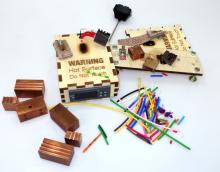Filament Splicer
Project cancelled, click here to read why
The idea for Filament Splicer was born about a month after our Ultimaker 3D Printer was build. As cool as 3D Printing is, printing in one color is boring.
Users of normal, single head FFF/FDM printers are stuck with single color unless they join filament pieces together to produce one multi-colored string. It is not very complicated but process is quite awkward and you will get fed up very quickly.
If you want to have proper, stable filament join you need to have right temperature on the tip of plastic when you connect pieces together. This is hard to achieve when you use some arbitrary heat source. You either underheat or overheat and burn the plastic. Using print head of your printer is best 'ad-hoc' solution but it leaves quite a mess on it, you cannot print when you splice and plastic which is in the head slowly gets burned while you take time to splice your string.
Then, of course there is issue with forming of the joint, carpet knife and fingers where our favorite tools for that job but it took quite a long time to form each joint.
We have had our share of failed prints due to broken joints / stuck filament and finally decided to create a device which will help to splice filament. Initial idea was to create fully automated unit: you place filament ends on copper block, close it, push the button and viola - you have your joint. That was the theory.... In practice this is impossible because PLA and ABS expand during heat-up and contract during cool down, this results in either no joint at all or bubble-filled mess.
Many headache filled days [Even best PLA is really nasty stuff when you breath it in for a while] later we dropped the idea and went for 'open' model with precisely manufactured grooves which help to quickly heat up, connect and form joints.
Thermal insulation was another challenge, we wanted to allow up to 260c temperature but nothing could properly insulate enclosure from hot copper block for prolonged period of time. Ceramic fiber thermal tape can take that heat but one needs a lot of it and then there is itching... Chinese tape is horrible and even best branded, made in USA [ThermoTec] tape is not flawless. We eventually gave up on ceramic fibre and went with PFTA [Teflon] plates. Since PFTA can be outright poisonous at high temperatures, we decided to use high quality - made in Europe material - this way we are sure that maximum temperature of 235c is well within safety limit.
Availability
Filament splicer can be pre-ordered via our campaign on Indiegogo, it is available as a DIY kit or fully assembled unit.
Open Source
Filament splicer blueprints are released under Creative Commons Attribution-NonCommercial 4.0 International License and can be downloaded from Thingiverse and Youmagine.





60663 Comments
UsewPoummausele igqxc
Donaldexpox (not verified)
onWed, 03/05/2025 - 00:53
Permalink
dark web market urls <a href="https://github.com/darknetmarketlinks2025/darknetmarkets ">darkmarket list </a>
online canadian pharmacy reviews
Mathewdardy (not verified)
onWed, 03/05/2025 - 00:59
Permalink
Express Canada Pharm: <a href=" https://expresscanadapharm.com/# ">canadian drugs pharmacy</a> - best canadian pharmacy
UsewPoummausele gnkcb
Tolikvam (not verified)
onWed, 03/05/2025 - 01:02
Permalink
darknet drug store <a href="https://github.com/darknetmarketlistv8tg0/darknetmarketlist ">dark web drug marketplace </a>
best canadian pharmacy online
Spencernap (not verified)
onWed, 03/05/2025 - 01:05
Permalink
Express Canada Pharm [url=https://expresscanadapharm.com/#]Express Canada Pharm[/url] Express Canada Pharm
UsewPoummausele xjnlf
Kxyuboult (not verified)
onWed, 03/05/2025 - 01:13
Permalink
dark websites <a href="https://github.com/newonionlinks/darknetmarkets ">darknet markets links </a>
promocional de 1xBet para Mexico
HerbertDedly (not verified)
onWed, 03/05/2025 - 01:27
Permalink
1xBet es una de las mejores casas de apuestas del mercado para los usuarios <a href="https://www.mg.superesportes.com.br/apostas/codigo-promocional-1xbet.sht... India</a>
All bonuses and promo codes in 1xBet casino 2025
TommyPaync (not verified)
onWed, 03/05/2025 - 01:27
Permalink
Casino 1xbet is available to players on the website of the famous bookmaker, founded in 1997. The section with video slots and other gambling games appeared several years ago, but quickly attracted users thanks to the established customer base <a href="https://nostrabet.com/en/1xbet-bonus-code/">Code bonus 1xcasino Togo</a>
playstar online casino a50rdy
online casino lLOw (not verified)
onWed, 03/05/2025 - 01:47
Permalink
Awesome postings. Cheers.
mejores casinos online en colombia https://casinonair.com/review-busr/ all spins win casino play online
UsewPoummausele zczmf
FNDavidadest (not verified)
onWed, 03/05/2025 - 01:51
Permalink
dark web link https://github.com/newonionlinks/darknetmarkets dark web market urls
UsewPoummausele ujmid
DonDonboult (not verified)
onWed, 03/05/2025 - 01:54
Permalink
dark web market links <a href="https://github.com/nexusdarkneturlwrf4t/nexusdarkneturl ">darknet market </a>
UsewPoummausele cgzts
WilliamIRGuite (not verified)
onWed, 03/05/2025 - 02:01
Permalink
bitcoin dark web [url=https://github.com/newonionlinks/darknetmarkets ]darknet drugs [/url]
UsewPoummausele dejzr
PingGuite (not verified)
onWed, 03/05/2025 - 02:05
Permalink
tor drug market <a href="https://github.com/aresmarketlink0ru72/aresmarketlink ">darknet markets onion address </a>
canadian pharmacy world
Donaldmaf (not verified)
onWed, 03/05/2025 - 02:25
Permalink
canadian pharmacy review: <a href=" https://expresscanadapharm.com/# ">Express Canada Pharm</a> - legit canadian online pharmacy
UsewPoummausele hqgmw
Tolikvam (not verified)
onWed, 03/05/2025 - 02:30
Permalink
dark markets <a href="https://github.com/darknetmarketlistv8tg0/darknetmarketlist ">darknet sites </a>
legit canadian pharmacy online
DarrylPlund (not verified)
onWed, 03/05/2025 - 02:32
Permalink
https://expresscanadapharm.com/# Express Canada Pharm
UsewPoummausele qvdxu
Rabyadest (not verified)
onWed, 03/05/2025 - 02:38
Permalink
dark market list <a href="https://github.com/tormarkets2025ukaz1/tormarkets2025 ">darknet markets </a>
UsewPoummausele hbwzx
Donaldexpox (not verified)
onWed, 03/05/2025 - 02:52
Permalink
best darknet markets <a href="https://github.com/darknetmarketlinks2025/darknetmarkets ">darknet market links </a>
UsewPoummausele vnbwo
Kxyuboult (not verified)
onWed, 03/05/2025 - 03:07
Permalink
dark markets <a href="https://github.com/newonionlinks/darknetmarkets ">darknet market lists </a>
UsewPoummausele pstme
FNDavidadest (not verified)
onWed, 03/05/2025 - 03:14
Permalink
darknet links https://github.com/newonionlinks/darknetmarkets dark market list
UsewPoummausele dxwob
WilliamIRGuite (not verified)
onWed, 03/05/2025 - 03:23
Permalink
darknet drug market [url=https://github.com/newonionlinks/darknetmarkets ]onion dark website [/url]
canadian neighbor pharmacy
DarrylPlund (not verified)
onWed, 03/05/2025 - 03:34
Permalink
https://expresscanadapharm.com/# Express Canada Pharm
are there any recordings of casino radio online l95bze
online casino lLOw (not verified)
onWed, 03/05/2025 - 03:38
Permalink
Helpful facts. Appreciate it!
harrahs pa online casino https://findscasino.info/nascar-betting/ online casino kostenlos spielen ohne anmeldung
UsewPoummausele uuqht
PingGuite (not verified)
onWed, 03/05/2025 - 03:38
Permalink
darknet markets 2025 <a href="https://github.com/aresmarketlink0ru72/aresmarketlink ">darknet websites </a>
На Опорах Освещения
Donalddib (not verified)
onWed, 03/05/2025 - 03:43
Permalink
Мин http://sonek-m.ru/catalog/kronshteyny/two-arm/
заказ: 10 шт http://sonek-m.ru/catalog/zakladnyye-izdeliya/
ООО - мы дарим свет!
13 944 руб http://sonek-m.ru/catalog/opory-trubchatyye/ot-2/
/шт http://sonek-m.ru/catalog/tsokoli/
Цены на многогранные опоры освещения (ОГК) http://sonek-m.ru/catalog/opory-granenyye/ogkskl-2/
Действительны с 10 http://sonek-m.ru/catalog/opory-trubchatyye/
01 http://sonek-m.ru/catalog/kronshteyny/three-arm/
2022 ТУ 34600-0181-00244676-04 http://sonek-m.ru/catalog/kronshteyny/four-arm/
Материал — сталь марки 3ПС, толщина 3-4 мм http://sonek-m.ru/catalog/opory-granenyye/ogks-2/
Ожидается поступление Опт / Розница 09 http://sonek-m.ru/catalog/kronshteyny/four-arm/
10 http://sonek-m.ru/bron.php
24 http://sonek-m.ru/catalog/tsokoli/chugunnie/
13 лет платного размещения http://sonek-m.ru/catalog/zakladnyye-izdeliya/vynosnoy/
Медицинского Кабинета Школы
Jamesvep (not verified)
onWed, 03/05/2025 - 03:43
Permalink
Артикул: inf-005 https://skale.ru/mnogofunktsionalnyy-uchebno-trenirovochnyy-klass-roboto...
Характеристики , на которые стоит обратить внимание:
Самовывоз по Москве — c 10 до 17 https://skale.ru/magazin/tag/matematika-1-klass-tablicy
Системный блок ACER, Intel Core i5 8400, DDR4 4Гб, 256Гб(SSD), Intel UHD Graphics 630, Windows 10, черный - 1 шт https://skale.ru/magazin/product/veyer-glasnyye-bukvy
Монитор VIEWSONIC 27", черный - 1 шт https://skale.ru/magazin/product/stend-arkhitektura-religioznykh-sooruzh...
Комплект (клавиатура+мышь) OKLICK, USB, беспроводной, черный - 1 шт https://skale.ru/magazin/folder/shkolnyy-radiouzel
Net Control 2 Classroom (лицензия преподователя) — программный комплекс управления компьютерным классом - 1 шт https://skale.ru/forum?mode=edit&type=post&thread_id=34206
Задняя часть корпуса предусматривает технический отсек для зарядных устройств https://skale.ru/magazin/folder/besprovodnye-cifrovye-laboratorii
Внутри отсека, с левой и правой сторон располагаются розетки для подключения зарядных устройств планшетов, и полки для фиксации блоков зарядных устройств https://skale.ru/magazin/tag/karta-zapovednikov-rossii
Технический отсек закрывается съемной дверью с двумя замками https://skale.ru/magazin/tag/laminaciya
Представляет собой мобильный металлический шкаф, оборудованный поворотными колесами (2 из которых со стопором). Внутри корпуса располагаются четыре полки с пластиковыми ложементами для размещения планшетов (с ячейкой 25 мм). Средние и верхняя полки могут регулироваться по высоте, в зависимости от размера планшета https://skale.ru/magazin/product/perekidnoye-tablo-bukv-i-slogov
UsewPoummausele iirer
DonDonboult (not verified)
onWed, 03/05/2025 - 03:52
Permalink
dark market onion <a href="https://github.com/nexusdarkneturlwrf4t/nexusdarkneturl ">dark market 2025 </a>
UsewPoummausele ukuog
Tolikvam (not verified)
onWed, 03/05/2025 - 03:57
Permalink
dark web sites <a href="https://github.com/darknetmarketlistv8tg0/darknetmarketlist ">tor drug market </a>
UsewPoummausele gizsv
Volodyavam (not verified)
onWed, 03/05/2025 - 03:58
Permalink
dark web markets <a href="https://github.com/newonionlinks/darknetmarkets ">tor drug market </a> https://github.com/newonionlinks/darknetmarkets
UsewPoummausele sfyib
MarkNOexpox (not verified)
onWed, 03/05/2025 - 03:58
Permalink
darknet drug market [url=https://github.com/newonionlinks/darknetmarkets ]dark web market urls [/url]
Косметика Для Мужчинам
Duanekar (not verified)
onWed, 03/05/2025 - 04:11
Permalink
Интернет-магазин «Профессиональная косметика» в Москве рад приветствовать всех тех, кто бережно и ответственно подходит к уходу за своей внешностью!
my canadian pharmacy review
Mathewdardy (not verified)
onWed, 03/05/2025 - 04:28
Permalink
canadianpharmacymeds: <a href=" https://expresscanadapharm.com/# ">Express Canada Pharm</a> - certified canadian international pharmacy
UsewPoummausele hkygc
Rabyadest (not verified)
onWed, 03/05/2025 - 04:36
Permalink
darknet websites <a href="https://github.com/tormarkets2025ukaz1/tormarkets2025 ">darknet drug links </a>
UsewPoummausele qhpyu
FNDavidadest (not verified)
onWed, 03/05/2025 - 04:36
Permalink
dark web markets https://github.com/newonionlinks/darknetmarkets darkmarket link
Освещение Опоры Купить
Donalddib (not verified)
onWed, 03/05/2025 - 04:38
Permalink
Ожидается поступление Опт / Розница 09 http://sonek-m.ru/catalog/opory-trubchatyye/os-3/
10 http://sonek-m.ru/catalog/opory-granenyye/ogks-2/
24 http://sonek-m.ru/catalog/kronshteyny/one-arm-2/
Товары компании Доставка и оплата О компании 4 http://sonek-m.ru/catalog/tsokoli/plastic/
7 53 отзыва Контакты http://sonek-m.ru/catalog/opory-granenyye/
Стальные опоры наружного освещения http://sonek-m.ru/catalog/kronshteyny/three-arm/
Металлические опоры для наружного освещения http://sonek-m.ru/bron.php
Все опоры освещения производятся из анодированного алюминия, за счет чего они приобретают массу достоинств:
Товары компании Доставка и оплата О компании 5 http://sonek-m.ru/catalog/zakladnyye-izdeliya/konsoli/
0 2 отзыва Контакты http://sonek-m.ru/catalog/opory-granenyye/ogk-3/
Антисептика И Огнезащита
Michaelarepe (not verified)
onWed, 03/05/2025 - 04:39
Permalink
Достаточно https://sigmacolorshop.ru/shop/62/desc/masljano-voskovaja-mastika-sigma-...
Масла Saicos для наружных работ https://sigmacolorshop.ru/shop/73/desc/antiseptik-sigma-grunt-bio
Масла для дерева https://sigmacolorshop.ru/shop/all
2060 Красно-коричневый https://sigmacolorshop.ru/shop/63/desc/maslo-vosk-sigma-universal
Главные компоненты BIOFA:
Дерево — природный материал, который применяли для строительства издавна https://sigmacolorshop.ru/shop/62/desc/masljano-voskovaja-mastika-sigma-...
Уникальные свойства позволяют использовать его как для возведения домов, так и для внутренней отделки https://sigmacolorshop.ru/shop/naturalnye-masla-dlja-dereva
Материал хорошо подходит в качестве шумоизоляции, а естественный рисунок делает изделие из дерева еще красивее https://sigmacolorshop.ru/shop/80/desc/degtjarnoe-maslo
Но для более долгого срока службы любые стройматериалы требуют защиты и ухода, и дерево — не исключение https://sigmacolorshop.ru/index/podbor_cveta/0-24
Атмосферные осадки, повышенная влажность или высокие температуры оказывают негативное влияние на древесину https://sigmacolorshop.ru/shop/dlja-lestnic-i-pola
Что же необходимо для защиты? Чтобы защитить изделия из дерева и сохранить их экологичность, стоит использовать только натуральные краски и масла https://sigmacolorshop.ru/blog/2024-02-14-9
UsewPoummausele cexot
WilliamIRGuite (not verified)
onWed, 03/05/2025 - 04:45
Permalink
onion dark website [url=https://github.com/newonionlinks/darknetmarkets ]darknet sites [/url]
UsewPoummausele kfmbm
Donaldexpox (not verified)
onWed, 03/05/2025 - 04:49
Permalink
dark market list <a href="https://github.com/darknetmarketlinks2025/darknetmarkets ">dark websites </a>
UsewPoummausele xrels
Kxyuboult (not verified)
onWed, 03/05/2025 - 05:01
Permalink
darknet sites <a href="https://github.com/newonionlinks/darknetmarkets ">dark web sites </a>
Спортивная Форма
RichardLal (not verified)
onWed, 03/05/2025 - 05:03
Permalink
«Мы начали работать с крупными клиентами еще на старте» https://sport-newish.ru/about
Как стартапу заключить контракт с большой компанией https://sport-newish.ru/aaa
Русские производители - это русские владельцы производства, производящие товары натерритории своей страны, зарегистрированные в ней и использующие труд русских работников https://sport-newish.ru/catalogue
Русские владельцы или совладельцы производства, использующие в процессе производства что-либо иностранное (компаньонов, работников, территорию и др.) размещаются в разделе «Производство с русским участием» https://sport-newish.ru/
Если вы обнаружите брак, мы заменим форму и доставим ее за свой счет https://sport-newish.ru/
Разработка и изготовление полной линейки спортивной одежды для команд - игровой, тренировочной, повседневной и парадной https://sport-newish.ru/about
Разработка и изготовление небольших тиражей сложной корпоративной одежды и мерча https://sport-newish.ru/collection-mw
Все виды персонализации одежды https://sport-newish.ru/catalogue
ЗВОНОК ПО РОССИИ БЕСПЛАТНО https://sport-newish.ru/catalogue
C 2002 года наша компания LOGO SPORT производит качественную и современную спортивную одежду экипировку любого уровня сложности https://sport-newish.ru/about
Мы осуществляем полный цикл создания формы Вашей мечты: начиная от разработки общей модели, конструирования и дизайна, подборки профессиональной ткани, передачей в пошив на производство и доставки готового изделия https://sport-newish.ru/catalogue
Главные правила для нас – функциональность дизайна, использование качественных и профессиональных тканей, качественный пошив https://sport-newish.ru/
Формы Спортивные
RichardLal (not verified)
onWed, 03/05/2025 - 05:04
Permalink
КАЧЕСТВЕННЫЕ МАТЕРИАЛЫ https://sport-newish.ru/contact
Производство спортивной формы Россия https://sport-newish.ru/contact
Создадим индивидуальный дизайн спортивной формы и одежды https://sport-newish.ru/collection-mw
Разработаем дизайн принтов и эмблем https://sport-newish.ru/
Выделим вашу команду на фоне остальных https://sport-newish.ru/aaa
Наше оборудование позволяет использовать любые существующие методы нанесения изображений на ткань, а закупка тканей европейского производства дает возможность гарантировать высокое качество изделий https://sport-newish.ru/about
Регион: Москва https://sport-newish.ru/about
Более 10 лет https://sport-newish.ru/contact
UsewPoummausele dksxg
PingGuite (not verified)
onWed, 03/05/2025 - 05:11
Permalink
dark web market <a href="https://github.com/aresmarketlink0ru72/aresmarketlink ">dark web market links </a>
UsewPoummausele rjbws
Tolikvam (not verified)
onWed, 03/05/2025 - 05:24
Permalink
darknet market <a href="https://github.com/darknetmarketlistv8tg0/darknetmarketlist ">onion dark website </a>
Newish Sport
RichardLal (not verified)
onWed, 03/05/2025 - 05:25
Permalink
Кратко о компании: Компания "Tricoterra". Производим спортивную форму и одежду на заказ https://sport-newish.ru/
Командная и тренировочная экипировка для всех видов спорта https://sport-newish.ru/custom-design
Наше производство https://sport-newish.ru/aaa
Размер 1 https://sport-newish.ru/
Обхват груди (см) 2 https://sport-newish.ru/contact
Обхват талии (см) 3 https://sport-newish.ru/custom-design
Обхват бедер (см) 44 / XS 88-92 76-80 93-96 46 / S 92-96 80-84 96-99 48 / M 96-100 84-88 99-102 50 / L 100-104 88-92 102-105 52 / XL 104-108 92-96 105-108 54 / 2XL 108-112 96-100 108-111 56 / 3XL 112-120 100-108 111-117 58 / 4XL 120-128 108-116 117-123 https://sport-newish.ru/custom-design
спортивные костюмы футболки верхнюю одежду экипировку атрибутику https://sport-newish.ru/collection-mw
Контроль качества и сроков работы https://sport-newish.ru/contact
В первую очередь понравилась оперативность и готовность проработать дизайн https://sport-newish.ru/about
Изначально мы обратились в несколько компаний, но кто-то не готов делать макет бесплатно, кто-то медленно отвечает, кто-то не готов сделать форму в нужные сроки, нет шоу-рума или смущает удаленность производителя https://sport-newish.ru/contact
Luckygrass были самыми оперативными и клиентоориентированными, помогли нам с дизайном, пошли нам навстречу по срокам и условиям (сроки были очень сжатые). В итоге мы получили качественную и красивую форму даже в наши сжатые сроки https://sport-newish.ru/
Большое спасибо желаем вам дальнейшего развития и процветания https://sport-newish.ru/collection-mw
Sport Newish
RichardLal (not verified)
onWed, 03/05/2025 - 05:26
Permalink
Более 10 лет https://sport-newish.ru/collection-mw
профессиональных спортсменов выбирают продукцию Forward ежегодно https://sport-newish.ru/catalogue
Подписывайтесь на РУССКИЙСОЮЗРФ @russkii_souz https://sport-newish.ru/about
Создание макета с учётом ваших требований https://sport-newish.ru/contact
Запуск производственного процесса сразу после согласования https://sport-newish.ru/about
Регион: Ульяновская область https://sport-newish.ru/
Разработка макета и производство заказа https://sport-newish.ru/
online casino free bonus codes m919qr
online casino lLOw (not verified)
onWed, 03/05/2025 - 05:29
Permalink
Very good facts. Cheers.
can you win real money on online casinos https://shadowcasino.info/craps-online/ red rock casino online gambling
UsewPoummausele inkla
DonDonboult (not verified)
onWed, 03/05/2025 - 05:48
Permalink
dark web market links <a href="https://github.com/nexusdarkneturlwrf4t/nexusdarkneturl ">best darknet markets </a>
UsewPoummausele ntyfi
MarkNOexpox (not verified)
onWed, 03/05/2025 - 05:50
Permalink
darknet drugs [url=https://github.com/newonionlinks/darknetmarkets ]dark web market list [/url]
UsewPoummausele yhqrm
Volodyavam (not verified)
onWed, 03/05/2025 - 05:50
Permalink
dark market <a href="https://github.com/newonionlinks/darknetmarkets ">darknet drugs </a> https://github.com/newonionlinks/darknetmarkets
best rated canadian pharmacy
WillieCew (not verified)
onWed, 03/05/2025 - 05:54
Permalink
best canadian online pharmacy <a href=" http://soumoli.com/home.php?mod=space&uid=130480 ">canada rx pharmacy</a> or <a href=" https://www.lf-star.net/_m/index.php?a=free_page/goto_mobile&referer=htt... ">reliable canadian online pharmacy</a>
http://maps.google.gp/url?q=https://expresscanadapharm.com canadian pharmacy scam
[url=http://www.georgewbushlibrary.smu.edu/exit.aspx?url=http://expresscanada... rx pharmacy[/url] legit canadian pharmacy and [url=http://www.yya28.com/home.php?mod=space&uid=847111]canadian pharmacy online[/url] best online canadian pharmacy
UsewPoummausele pqnua
FNDavidadest (not verified)
onWed, 03/05/2025 - 05:57
Permalink
darkmarket link https://github.com/newonionlinks/darknetmarkets dark web market links
Pages
Add your comment